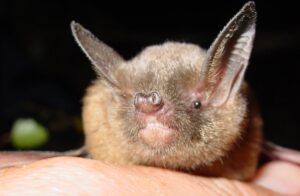
Mystacina tuberculata. Colin O’Donnell, DOC.
Bat1K is an initiative to sequence the genomes of all living bat species, approximately 1400 species in total. The group aims to uncover the genes and genetic mechanisms behind the unusual adaptations of bats, essentially mine the bat genome to uncover their secrets.
The New Zealand lesser short-tailed bat (Mystacina tuberculata) stands apart from its bat counterparts around the world. Native to New Zealand and endangered, it holds the distinction of being the most terrestrial of all bat species. It is one of the few bats in the world that spends large amounts of time on the forest floor, using its folded wings as ‘front limbs’ for scrambling around.
What does this have to do with wine research?
Last year, BRI installed an Oxford Nanopore PromethION Sequencer at our Grapevine Improvement Laboratory to understand genetic differences among grapevines. As this was the first high-throughput third-generation sequencer in New Zealand, we also made this enabling technology available as a service to other researchers from any field.
Bat1K researchers have been collaborating with BRI to sequence the genome of New Zealand’s native bat. Understanding the genetic makeup of these unique bats will allow researchers to delve into their adaptations, flight mechanisms, and terrestrial behaviours. Furthermore, it can shed light about their evolutionary history and place in the bat family tree and potentially help create more effective conservation strategies.
Access to PromethION DNA sequencing is now available to Aotearoa’s researchers. For more information, or to discuss potential projects, contact: sequencing@bri.co.nz

















